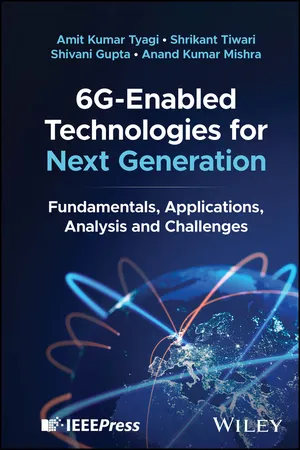
6G-Enabled Technologies for Next Generation
Fundamentals, Applications, Analysis and Challenges
- 459 pages
- English
- PDF
- Available on iOS & Android
6G-Enabled Technologies for Next Generation
Fundamentals, Applications, Analysis and Challenges
About this book
A comprehensive reference on 6G wireless technologies, covering applications, hardware, security and privacy concerns, existing challenges, analytics methods, and much more
6G-Enabled Technologies for Next Generation delivers a thorough overview of the emerging sixth generation of wireless technology, presenting critical challenges of implementing 6G technologies including spectrum allocation, energy efficiency, security, interoperability, and more. Explaining ways we can use technologies to ensure a sustainable environment through renewable energy and a resilient industry, this book covers the applications and use cases such as smart grid, IoT, smart manufacturing, addressing security and privacy issues with privacy-preserving techniques and authentication control mechanisms.
This book discusses the analytical methods used to study the performance of 6G technologies, covering simulation techniques, performance metrics, and predictive modeling. Introducing the core principles of 6G technology, including the advantages and disadvantages of the technology and how wireless communications have evolved, energy-efficient hardware and the different types of green communication technologies is explained. Many case studies are included in this book with a detailed explanation.
Written by a team of experienced researchers, this book discusses:
- Terahertz (ThZ) communication, massive MIMO and beamforming, quantum communication, bandwidth management, and ultra-dense networks and small cell deployments
- Smart cities, telemedicine, and autonomous vehicles and schemes for waveform design, modulation, error correction, and advanced coding and modulation
- Sensor networks, edge computing and mobile cloud computing, and spatial, quantum, and dew computing
- Quantum-safe encryption, privacy-preserving technologies and techniques, threats and vulnerabilities, and authentication and access control mechanisms
- Network slicing and service differentiation, multi-connectivity and heterogeneous networks, and wireless power transfer
6G-Enabled Technologies for Next Generation is a comprehensive, up-to-date reference for students, academics, and researchers, along with professionals in the telecommunications field.
Frequently asked questions
- Essential is ideal for learners and professionals who enjoy exploring a wide range of subjects. Access the Essential Library with 800,000+ trusted titles and best-sellers across business, personal growth, and the humanities. Includes unlimited reading time and Standard Read Aloud voice.
- Complete: Perfect for advanced learners and researchers needing full, unrestricted access. Unlock 1.4M+ books across hundreds of subjects, including academic and specialized titles. The Complete Plan also includes advanced features like Premium Read Aloud and Research Assistant.
Please note we cannot support devices running on iOS 13 and Android 7 or earlier. Learn more about using the app.
Information
Table of contents
- Cover
- Title Page
- Copyright
- Contents
- About the Authors
- Preface
- Acknowledgments
- Chapter 1 6G‐Enabled Technologies: An Introduction
- Chapter 2 Fundamentals of 6G Networks
- Chapter 3 Next‐Generation Air Interfaces for 6G
- Chapter 4 Enabling Technologies for 6G‐Based Advanced Applications
- Chapter 5 Security and Privacy in 6G Networks
- Chapter 6 Applications and Use Cases of 6G Technology
- Chapter 7 Network Architecture and Protocols for 6G
- Chapter 8 Energy Efficiency and Sustainability in 6G Networks
- Chapter 9 Performance Evaluation and Optimization in 6G Networks
- Chapter 10 Network Planning and Deployment for 6G‐Based Systems in Real World
- Chapter 11 Standardization and Regulatory Aspects for 6G‐Based Networks and Systems
- Chapter 12 Economic and Business Perspectives of 6G Technology for Modern Society
- Chapter 13 Ethical and Social Implications of Using Artificial Intelligence in 6G Networks
- Chapter 14 Future Trends and Research Directions for 6G
- Chapter 15 Evolution of Hybrid Li‐Fi–Wi‐Fi Networks: Technology, Barriers, Advancement, and Future
- Chapter 16 6G‐Enabled Emerging Technologies for Next‐Generation Society: Challenges and Opportunities
- Chapter 17 Conclusion
- Index
- EULA